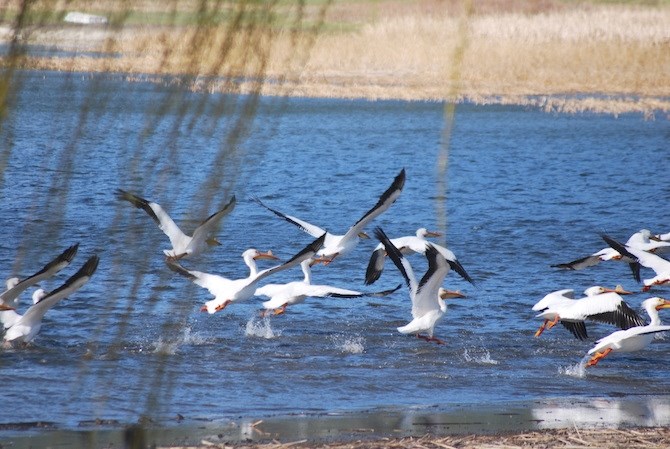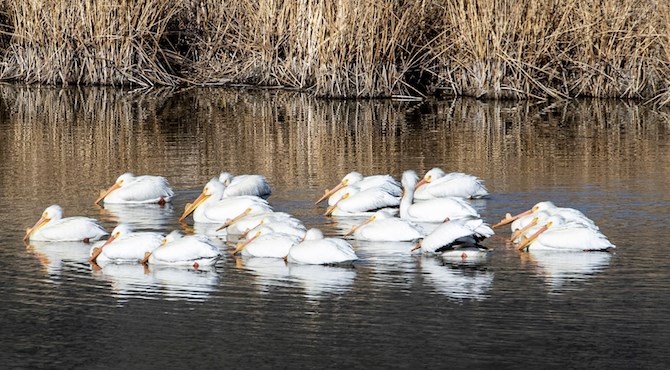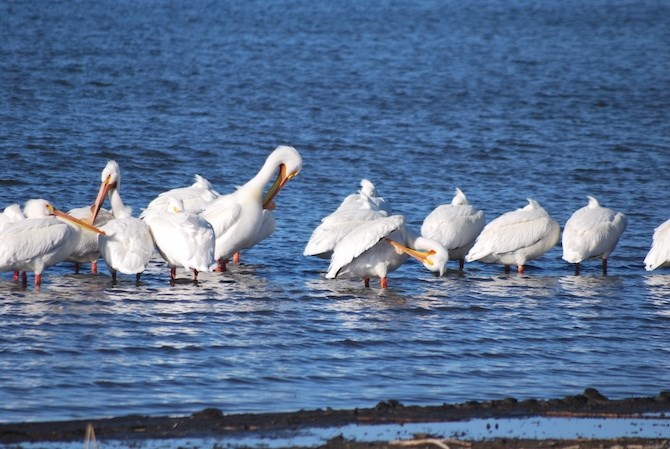
Barbara Proulx took this photo of pelicans at the north end of Okanagan Lake on April 22.
Image Credit: SUBMITTED/ Barbara Proulx
April 23, 2021 - 7:00 AM
It’s prime time for the spring migration of the biggest flying bird in Canada, and the Okanagan valley is central to the route to their breeding grounds.
Biologist Richard Cannings (also South Okanagan-West Kootenay MP) has authored several books about British Columbia birds. He says from April 15 to 25 is generally the peak time for the American white pelican’s migration north from the Central Valley of California to its breeding ground at Stum Lake in the Chilcotin, northwest of Williams Lake.
“They don’t make noise, so you have to look up at the right time to see them. A number of flocks went over the South Okanagan yesterday,” Cannings says.
He says roughly 300 pairs make the trip to Stum Lake every year. Others can be found here and there in the Okanagan throughout the summer, part of a non-breeding population of young pelicans that find their home around parts of Eastern Washington State, and in the Creston area, as well as in parts of the Okanagan.

Oliver resident Mike Fitzpatrick took this photo of pelicans in the Okanagan River oxbows last Sunday, April 18, 2021.
Image Credit: Facebook/ Mike Fitzpatrick
“There might be 20 to 50 that hang around here all summer. You might see them at Vaseux or Osoyoos Lake, or in Salmon Arm in late June through August,” Cannings says.
The birds fly a very specific route, taking a course along the west side of the Okanagan valley as far as Peachland. From there, the birds divert away from the Okanagan and make their way to the Chilcotin using the smaller inland lakes around Douglas Lake, like Chapperon and Sanctuary Lakes.
“There aren’t that many that can be seen flying through the Okanagan north of Kelowna,” Cannings says.
Oliver resident Mike Fitzpatrick posted a photo he took of pelicans in the Okanagan River oxbows earlier this week.

Barbara Proulx says yesterday's flock of pelicans were the first she has seen at the north end of Okanagan Lake.
Image Credit: SUBMITTED/ Barbara Proulx
The American white pelican is considered an endangered species in Canada. The bird can live for 17 years, but has a low reproductive rate, with a hatch of generally a single chick. Their world is a fragile one, as the slightest disturbance can result in the loss of the young.
Stum Lake Provincial Park protects the species' breeding grounds. The park is closed to the public from March 1 to Aug. 31 and aircraft are restricted to operations above 600 metres.
Aircraft also can’t land in the park between March and August, according to British Columbia.com

Barbara Proulx, who photographed these pelicans on April 22 at the north end of Okanagan Lake says the birds only stayed a short time.
Image Credit: SUBMITTED/ Barbara Proulx
— This story was updated at 10:06 a.m. Friday, April 23, 2021 with more photos.
To contact a reporter for this story, email Steve Arstad or call 250-488-3065 or email the editor. You can also submit photos, videos or news tips to tips@infonews.ca and be entered to win a monthly prize draw.
We welcome your comments and opinions on our stories but play nice. We won't censor or delete comments unless they contain off-topic statements or links, unnecessary vulgarity, false facts, spam or obviously fake profiles. If you have any concerns about what you see in comments, email the editor in the link above.
News from © iNFOnews, 2021